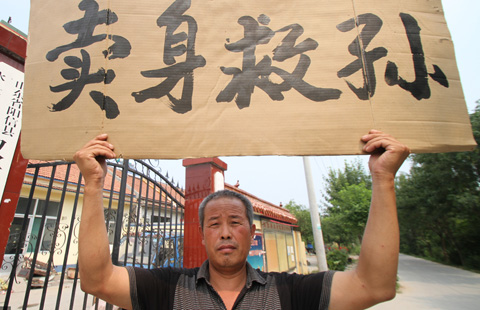Haze cure may need new Olympian vision
By Wu Wencong, Cui Jia and Tang Yue (China Daily) Updated: 2013-01-24 09:14During the recent severe smog, the levels of PM2.5 - particle matter smaller than 2.5 microns and able to enter the lungs and even the bloodstream - passed 900 micrograms per cubic meter on Jan 12. The World Health Organization considers the safe daily level to be 25 micrograms per cu m. However, the local transportation authority declined the opportunity to reintroduce the regulations in force during the Olympics as a long-term measure.
"Complaints can already be heard everywhere about the current regulation that only allows each car on the roads one day a week, so three or four days is not an option," said Du.
 |
|
Beijing was hit by another bout of heavy pollution on Wednesday, resulting in poor visibility. Luo Xiaoguang / Xinhua |
Government vehicles are also targeted when the situation is particularly dire. Thirty percent of official cars should disappear from the roads during highly polluted days, according to emergency procedures in Beijing and Shijiazhuang, the capital of Hebei province.
Energy consumption
Back in 2008, five cement factories in Taiyuan, the capital of Shanxi province, were required to reduce production by 50 percent and another five were temporarily closed until the Games had ended. Moreover, officials were sent to high pollution-generating manufacturers to monitor their production over the course of a day and to randomly inspect the quality of the coal or petrol being used.
Similar measures were also adopted in the municipality of Tianjin, and in Hebei province and the Inner Mongolia autonomous region.
However, the short break was unable to slow the ever-increasing consumption of energy nationwide. Coal production and consumption have tripled since 2000, while steel output is approximately five times higher.
"We are experiencing the high-speed development of the manufacturing industry. Under these circumstances, a solution to the problem of pollution is not just around the corner," said Su Yang, a senior research fellow at the State Council's Development Research Center.
While he admitted that China faces challenges, he was critical of the measures in the UK, saying that although the country has reduced pollution levels it has also almost completely given up on manufacturing.
"The manufacturing sector is the backbone of a great country," he said, adding that China can learn from Japan and Germany and try to adjust the patterns of economic development for different industries, thus reducing the proportion of sectors with high levels of pollution.
- Xi praises Cambodia royalty for cultivating friendship
- Li cites innovation in visits to high-tech firms
- Overseas studies pay off
- Xi: China backs stability and growth in Cambodia
- Li vows anew to ease market access
- Xi: China backs stability and growth in Cambodia
- Hopes rise as visit by Duterte set
- Xi stresses CPC leadership of state-owned enterprises
- New rules reduce conviction errors
- Smart technology to assist cancer treatment











